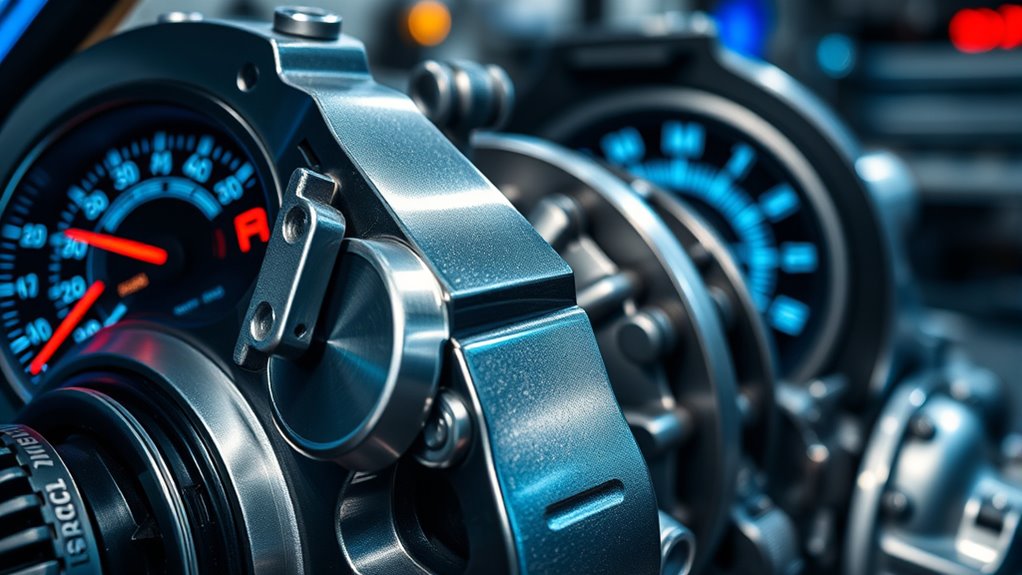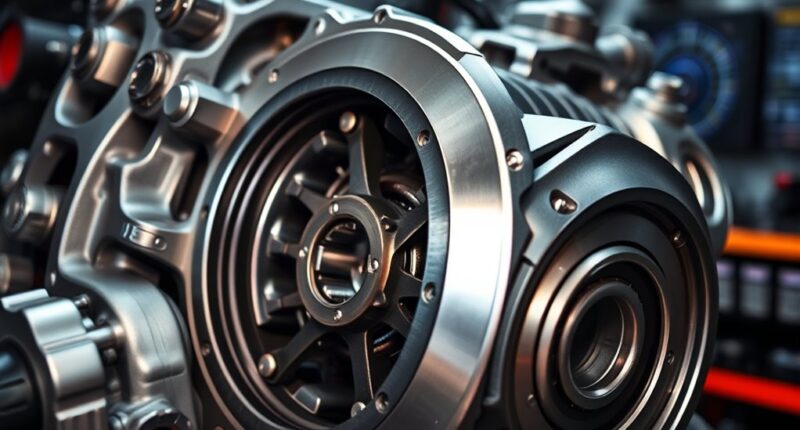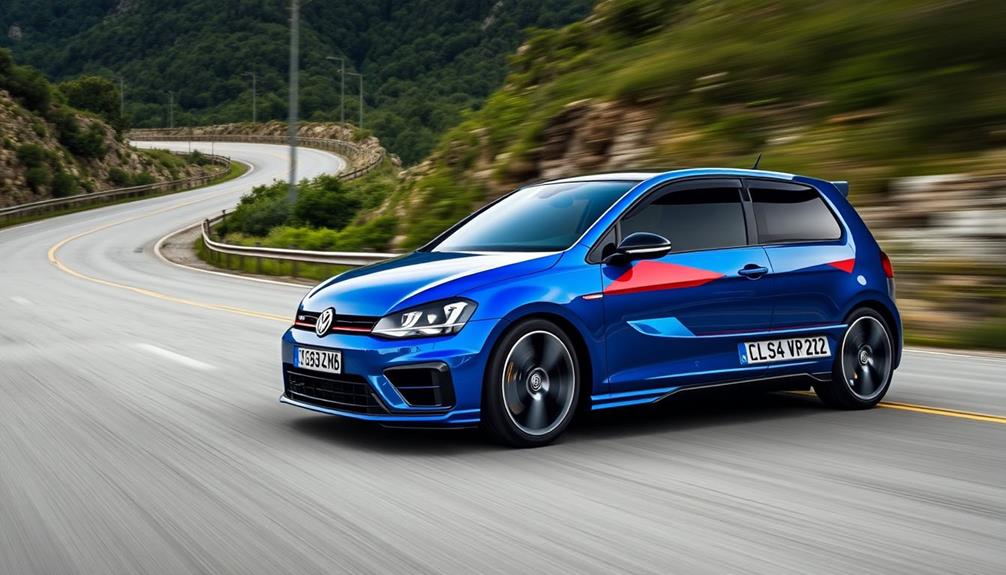Adjusting clutch pressure on your DSG DQ381 can make shifts feel sportier and more responsive, but it also increases stress on the clutch components. Higher pressure boosts responsiveness but can accelerate wear and shorten your transmission’s lifespan. Conversely, softer settings extend durability but may compromise shift firmness. Finding the right balance is key to enjoying performance without risking early damage. Keep exploring to discover how to optimize your setup for both performance and longevity.
Key Takeaways
- Increasing clutch pressure improves shift responsiveness but accelerates clutch wear, potentially reducing transmission lifespan.
- Lower clutch pressure enhances durability and smoothness but may result in slower, less aggressive shifts.
- Fine-tuning clutch pressure involves balancing optimal performance with manageable wear rates for longevity.
- Excessively high pressure can cause early clutch failure, leading to costly repairs over time.
- Coordinated adjustments with other parameters (shift timing, line pressure) help optimize durability and performance.

The DSG DQ381 transmission is a popular choice among car enthusiasts looking to boost performance, and tuning it can release significant improvements in power and driving experience. One of the key aspects to consider when tuning this transmission is how clutch pressure affects clutch engagement and gear shift behavior. By adjusting clutch pressure settings, you can influence how quickly and smoothly the transmission shifts gears, which directly impacts your driving dynamics.
If you opt for higher clutch pressure during tuning, you’ll notice that clutch engagement becomes more immediate and firm. This results in sharper, more responsive gear shifts, giving your car a sportier feel. However, increased clutch pressure also puts additional stress on the clutch packs, which can reduce their lifespan over time. It’s a trade-off: you get quicker, more aggressive shifts, but at the potential cost of durability. If your goal is maximum performance and you’re willing to accept more maintenance, this approach might suit you.
Conversely, lowering clutch pressure creates a more gentle and gradual clutch engagement. This smooths out gear shifts, making daily driving more comfortable and less stressful on the clutch components. The gear shift behavior becomes more refined, ideal for those who prioritize longevity and a seamless driving experience. Still, this softer engagement may slightly diminish the immediate responsiveness of your transmission, which could be noticeable during spirited driving.
It’s essential to strike a balance between clutch pressure and durability. Excessively high pressure can cause the clutch to wear out faster, leading to costly repairs. On the other hand, too low pressure might compromise shift speed and overall performance. Tuning professionals often recommend incremental adjustments, testing each change to observe how it affects clutch engagement and shift behavior. This iterative process helps you find the sweet spot where performance gains meet acceptable durability.
Keep in mind that the behavior of your gear shifts also depends on other tuning parameters, such as shift timing and line pressure. Fine-tuning these alongside clutch pressure will give you a customized driving feel that aligns with your needs. Remember, every modification influences the overall longevity of your transmission, so prioritize a balanced approach. Proper tuning can transform your DSG DQ381 into a more responsive, exhilarating drivetrain, but it’s vital to consider how clutch pressure adjustments will impact both clutch engagement and gear shift behavior over the long term.
Frequently Asked Questions
How Does Clutch Pressure Affect Fuel Efficiency?
Clutch pressure directly impacts fuel economy because it influences clutch engagement smoothness and efficiency. Higher clutch pressure can cause more slip and resistance, leading to increased fuel consumption. Conversely, optimizing clutch pressure allows for smoother engagement, reducing unnecessary slipping and conserving fuel. You’ll notice improved fuel economy when the clutch engages efficiently, minimizing power loss and enabling your vehicle to operate more economically. Proper clutch pressure tuning is key for balancing performance and fuel savings.
Can Tuning Improve DSG DQ381 Shift Response?
You can improve your DSG DQ381 shift response through tuning by optimizing clutch engagement and shift firmness. By adjusting these parameters, you make shifts quicker, smoother, and more responsive. Tuning enhances clutch engagement timing and increases shift firmness, reducing lag and improving driving feel. As a result, your transmission responds more swiftly to throttle inputs, delivering a more dynamic driving experience without sacrificing reliability or durability.
What Are Signs of Clutch Wear in DQ381?
You might notice clutch wear in your DQ381 if you experience slipping during acceleration or delayed clutch engagement. Unusual noises or a burning smell can also be signs. Pay attention to wear indicators on your vehicle’s dashboard, which alert you to potential issues. If you see these signs, it’s wise to have a mechanic inspect your clutch’s condition, as ongoing wear can lead to more significant transmission problems.
Is Aftermarket Tuning Reversible for Warranty Purposes?
When considering aftermarket modifications, you wonder if they’re reversible for warranty purposes. Generally, it’s possible to revert modifications, but warranty implications depend on the manufacturer and the extent of the changes. Keep in mind, some aftermarket tuning might void parts of your warranty if they cause issues. To protect yourself, document all modifications and consult your dealer beforehand, ensuring you understand how they might impact your vehicle’s warranty coverage.
How Does Climate Impact Clutch Durability After Tuning?
Did you know that hot climates can reduce clutch lifespan by up to 30%? Climate effects substantially influence durability factors, especially after tuning. High temperatures cause increased wear and tear, while cold weather can lead to sluggish clutch engagement. You should consider these environmental impacts because extreme climates can accelerate clutch degradation, making it vital to adapt your driving habits or improve cooling systems to maintain clutch longevity post-tuning.
Conclusion
If you’re considering tuning your DSG DQ381, don’t worry about sacrificing clutch durability. With proper tuning and regular maintenance, you can enjoy increased performance without risking premature wear. Some might think pushing the limits damages the transmission, but responsible tuning balances power with longevity. Trust experienced professionals to optimize your setup. Ultimately, with the right approach, you’ll get the thrill of improved driving while keeping your clutch healthy for years to come.










